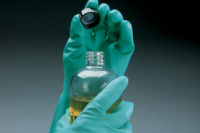 Often, employees who are exposed to chemical hazards need to use personal protective equipment (PPE) that includes gloves and, occasionally, chemical protective suits. Chemical protective suits and gloves come in a variety of materials, and no one material protects against all chemical hazards. When choosing PPE, it's important to understand how to properly select the material for the protective apparel your employees wear.
Often, employees who are exposed to chemical hazards need to use personal protective equipment (PPE) that includes gloves and, occasionally, chemical protective suits. Chemical protective suits and gloves come in a variety of materials, and no one material protects against all chemical hazards. When choosing PPE, it's important to understand how to properly select the material for the protective apparel your employees wear.
There are three basic criteria that determine chemical compatibility of chemical protective gloves and clothing: permeation rate, degradation, and breakthrough time.
Permeation rate:Permeation rate is a measurement of how quickly a chemical passes through a material at the molecular level. It can be thought of as a slow leak, similar to how air seeps through plastic soda bottles and makes your soda go flat (hence the expiration date on the bottles!). Thicker materials tend to have slower permeation rates. Permeation rates are reported differently by different manufacturers, but a higher number generally means a quicker penetration rate.
Degradation:Degradation is the physical changes to the material caused by the chemical, which can include swelling, stiffening, wrinkling, changes in color, and other physical deterioration. The slower the degradation occurs in the presence of a chemical, the more protective the material is for that specific chemical.
There are no standardized tests for degradation; each manufacturer generally has its own test.
Breakthrough time:Breakthrough time is how much time it takes from the initial contact of the chemical with the material until it is detected on the opposite side of the material (essentially, when it begins to soak through). Obviously, the greater the breakthrough time, the more protective the material is for that particular chemical.
Breakthrough is measured using a standardized test (ASTM F739).
Other considerations
In addition to permeation, degradation, and breakthrough, there are other considerations when buying chemical protective gloves and clothing:
· Just because a glove or chemical protective suit is made from the same material does not mean it is the same from one manufacturer to another. Manufacturers use different blends and manufacturing processes. For this reason, it is important to review the data from the specific glove and clothing manufacturer rather than a "generic" information source.
· Most chemical protective clothing and gloves are tested with single chemicals rather than mixtures. If you need to protect employees who use chemical mixtures, contact the manufacturer to discuss your specific situation.
· Chemical protective clothing is generally tested for specific concentrations of a chemical. Do not assume that because it was tested at a high concentration it will be sufficiently protective at a much lower concentration. If there is no test data for a chemical concentration that is similar to that which you are using, contact the manufacturer to determine if the material is compatible.
· Permeation, degradation, and breakthrough are measured under laboratory, rather than real-world, conditions.You need to examine whether your application has unique considerations that may make a particular material unsuitable for your use, for example, high temperature, low temperature, employee mobility needs, chemical mixtures, etc.
Because there is no one material that can protect against all chemicals, chemical protective gloves and clothing need to be selected on the specific application where it is needed. Understanding how the materials for this type of PPE are evaluated will help you make the appropriate choice for protecting your employees.


